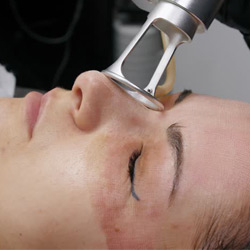


CO2 fractional
Find a solution for your scar problems
- Effective Treatment
- Permanent Scar Removal
- Lasting results
Everything You Need to Know About Laser Skin Resurfacing
What is laser skin resurfacing?
Laser skin resurfacing is a type of skin care procedure performed by an AESTHETICIAN. It involves using lasers to help improve skin texture and appearance.
Depending on your individual needs, your aesthetician may recommend either ablative or non-ablative lasers. Ablative lasers include carbon dioxide (CO2) or Erbium. CO2 laser resurfacing treatments are used to get rid of scars , warts , and deep wrinkles. Erbium is used for finer lines and wrinkles , along with other superficial skin concerns. Both types of ablative lasers remove outside layers of the skin.
Non-ablative lasers, on the other hand, don’t remove any skin layers. These include pulsed light, pulsed-dye lasers, and fractional lasers. Non-ablative lasers may be used for rosacea , spider veins , and acne-related skin concerns.
Keep reading to learn more about how the procedure works, why it’s done, and more.
Picture Gallery




Who should get this procedure?
You might consider this procedure if you have age-, sun-, or acne-related skin care concerns that aren’t treatable with over-the-counter (OTC) products.
Laser skin resurfacing can be used to treat one or more of the following skin concerns:
This procedure may not be suitable for people with active acne breakouts or excessive sagging skin.
What to expect from the procedure?
Laser skin resurfacing targets the outer layer of your skin while simultaneously heating the lower layers in the dermis. This will promote collagen production.
Ideally, new collagen fibres will help produce new skin that is smoother in texture and firmer to the touch.
The procedure involves the following steps
- On the day of the procedure, your doctor will apply a topical anaesthetic to the area being treated. This is used to reduce pain and make you more comfortable during the procedure. If a large area of skin is being treated, your doctor may suggest a sedative or pain killers.
- Next, the skin is cleansed to remove any excess oil, dirt, and bacteria.
- Your doctor begins the treatment, using the selected laser. The laser is moved slowly around the designated area of skin.
- Finally, your doctor will dress the treatment area in wraps to help protect the skin at the end of the procedure.
Ideally, new collagen fibres will help produce new skin that is smoother in texture and firmer to the touch.
What to expect from aftercare and recovery?
Although these procedures aren’t classified as surgeries. You can leave your doctor’s office immediately following the procedure.
Still, downtime and recovery are necessary to make sure your skin heals properly. This reduces your risk for side effects and helps you achieve the desired results.
Duration
Healing usually takes between 3 and 12 days. As a general rule, the bigger the treatment area and the deeper the laser, the longer the recovery time. Recovery from an ablative laser treatment, for example, may take up to three weeks.
During recovery, your skin may be extremely red and scab over. Slight peeling will occur. You can use ice packs to help reduce any swelling.
While you don’t need to be at home during the entire recovery process, you’ll want to avoid known areas of germs — such as the gym — that could increase your risk of infection.
Cleansing
You’ll also need to adjust your daily skin care routine. You’ll need to clean the treated area two to five times per day. Instead of your usual cleanser, you’ll use saline or vinegar-based solution recommended by your doctor.
You’ll also need to use new dressings to ensure your skin stays clean.
A daily moisturizer can also help with the healing process, but be sure to run this by your doctor first.
Protection
Your skin may be sun-sensitive for a while following each laser skin resurfacing procedure. Wearing sunscreen with a minimum SPF of 30 can help reduce your risk for sunburn and sun damage.
You should apply sunscreen every morning (even when it’s cloudy) to protect your skin. Make sure to reapply as needed throughout the day.
What to expect from the results?
Non-ablative laser treatments don’t pose as great of a risk for side effects, but you may need multiple treatments to achieve your desired results. Ablative lasers, on the other hand, may correct your concerns in one treatment.
Individual results vary based on the extent of the initial concerns being treated. You can expect your results to last for several years once you’re done with your treatment sessions. However, the results aren’t permanent. You may need to repeat the procedure at some point.
FAQS
IS THIS TREATMENT SUITABLE FOR ME?
You are a good candidate if your skin tone is light enough. if your problem spots are shallower in the skin. Lasers can make a big difference in shallow wrinkles, acne scarring and brown spots stretch marks.
HOW OFTEN DO I GET THIS TREATMENT?
The number depends on the extent of your damage, scarring or wrinkles, and on how much downtime you can accept. If you can tolerate 7 days of downtime, you would generally need around 2 to 6 fractional CO2 treatment. depending on your problem.
IS THIS TREATMENT PAINFUL?
… Most people feel very little pain during treatment. Rarely there is mild discomfort for the first day.
